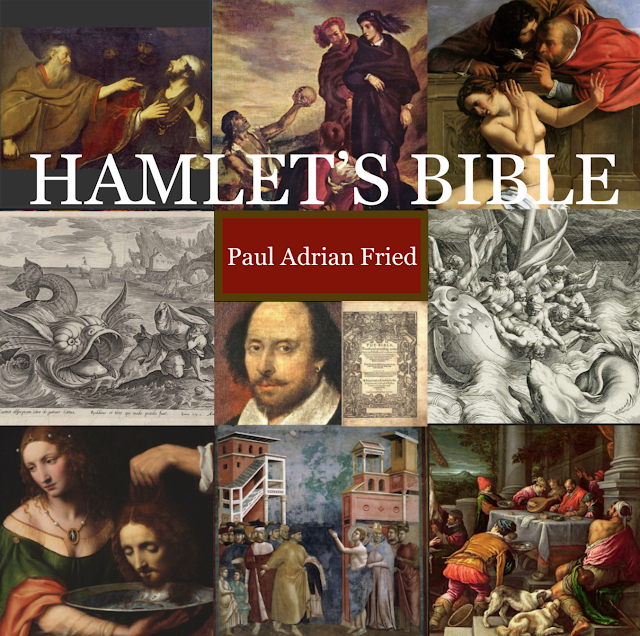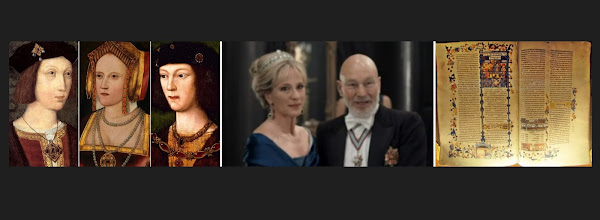Three challenges to teaching about incestuous marriage in Hamlet
There are always challenges to teaching Hamlet, in part due to the historical and cultural gaps between the original audiences for whom Shakespeare was writing, and that of today’s students. When teaching about the “incestuous” marriage of Claudius and Gertrude, one may find challenges especially in at least three areas: Definitions, religious considerations, and trigger warning issues.
[Left to right: Arthur Tudor, Prince of Wales (1486-1502), "regarded as the only surviving contemporary portrait"; circa 1500. Anglo-Flemish School. Private collection, Hever Castle, Kent. Public domain. Image via Wikimedia.
Catherine of Aragon (1485–1536), originally identified as Catherine Parr, but now recognized as Catherine of Aragon. Unidentified painter. 16th Century. Lambeth Palace. Public domain, via Wikimedia.
Henry VIII of England (1491-1547), circa 1509. Attributed to Meynnart Wewyck. Denver Art Museum. Public domain. Image via Wikimedia.
Penny Downie as Gertrude, and Patrick Stewart as Claudius, in Hamlet, RSC, directed by Gregory Doran. Fair use. Via PBS.org.
Mishneh Torah (Maimonides), Perugia, c. 1400 (Elie Kedouri, The Jewish World, 1979, p. 193). Illuminated Hebrew manuscript. National Library of Israel, Jerusalem. Photo is from replica at the Diaspora Museum, Tel Aviv. Fair use. Via Wikimedia.org.]
1. DEFINITIONS: If you ask students to explain their definition of incest, many might say that it involves sex between siblings.
In Shakespeare’s Hamlet, the term is used more broadly according to biblical prohibitions [1] and relations of "Kinship and Affinity" in the Book of Common Prayer regarding many types of family relations where marriage was prohibited.
Because (as Hamlet says) man and wife become "one flesh" (4.3) Gertrude becomes like a sister to Claudius through her first marriage, so for Claudius to marry her is considered incestuous, like marrying one's sister.
Such prohibitions were highlighted in debates about whether Henry VIII, in spite of special permission from the pope to marry his older brother’s widow, had been right to divorce her, his first wife.
The laws in the UK changed in 1907, allowing a widower to marry his deceased wife’s sister, and in 1921, allowing a widow to marry her deceased husband’s brother. [2]
Because it’s no longer illegal, and because there may be a large gap between what a student understands by “incestuous marriage” and what Shakespeare meant, clarification and historical background may be necessary.
2. RELIGIOUS CONSIDERATIONS: Modern students, on average, are much less familiar with biblical texts than the average person in Shakespeare’s London audiences. In the United States, because the constitution guarantees no established religion, some college students wrongly assume that this means they need never discuss the historical-religious contexts and biblical texts related to literature they study.
Some need reassurance that such discussion is not to convert students to the religion in question, but simply to enable them to understand the literature more fully.
3. TRIGGER WARNINGS AND RELATED CONSIDERATIONS: Some universities require or encourage instructors to give trigger warnings regarding potentially sensitive or traumatic material. This could be the case where a student or family member has been a victim of incest or sexual abuse.
Trigger warnings are controversial; some argue that they are unnecessary. But we might bear in mind that some students can be profoundly disturbed if they have been victims of traumatic experience, so I would argue in favor of the value of trigger warnings.
On the other hand, some such students may be drawn to such literature and find it cathartic. Instructors should be prepared for a variety of possibilities.
~~~~~~~
NOTES:
[1] See Leviticus 18 and my previous post, “"Incestuous" marriages of Henry VIII and Claudius: two relevant biblical passages” https://pauladrianfried.blogspot.com/2022/06/the-bible-henry-viii-claudius-and.html
For the listings of "Kindred and Affinity" from The Book of Common Prayer, see also
https://biblicalstudies.org.uk/pdf/expositor/series8/04-020.pdf
[2] This is not common, but it is certainly possible that a student’s parent may have died, and the surviving parent may have remarried, to the sibling of the deceased.
For a more detailed explanation, see
https://www.regencyhistory.net/2020/04/could-regency-widower-marry-his-wifes.html
Also see the following article at Mental Floss:
https://www.mentalfloss.com/article/49722/65-year-battle-over-deceased-wifes-sisters-marriage-act
And see the following article at Wikipedia on the Deceased Wife’s Sister’s Marriage Act of 1907:
https://en.wikipedia.org/wiki/Deceased_Wife%27s_Sister%27s_Marriage_Act_1907#1907_Act_and_subsequent_legislation
~~~~~~~
POSTS IN THIS SERIES ON THE BIBLICALLY "INCESTUOUS" MARRIAGE OF CLAUDIUS AND GERTRUDE,
AND THE ALLEGEDLY INCESTUOUS MARRIAGE OF HENRY VIII TO HIS FIRS WIFE:
1. Hamlet and the Incestuous Marriages of Claudius and Henry VIII - via John Erskine Hankins - 28 June, 2022
https://pauladrianfried.blogspot.com/2022/06/hamlet-and-incestuous-marriages-of.html
2. "Incestuous" marriages of Henry VIII and Claudius: two relevant biblical passages - 30 June, 2022
https://pauladrianfried.blogspot.com/2022/06/the-bible-henry-viii-claudius-and.html
3. How Hamlet toyed with Elizabethan expectations: Incestuous marriage, adultery, right succession - 5 July, 2022
https://pauladrianfried.blogspot.com/2022/07/how-hamlet-toyed-with-elizabethan.html
4. Three challenges to teaching about incestuous marriage in Hamlet - 7 July, 2023
https://pauladrianfried.blogspot.com/2022/07/three-challenges-to-teaching-about.html
~~~~~~~~~~~~~~~~~~~~~~~~
Disclaimer: If and when I quote or paraphrase bible passages or mention religion in many of my blog posts, I do not intend to promote any religion over another, nor am I attempting to promote religious belief in general; only to explore how the Bible and religion influenced Shakespeare, his plays, and his age.
~~~~~~~~~~~~~~~~~~~~~~~~
~~~~~~~~~~~~~~~~~~~~~~~~~~~~~~~~~~~~~~
Thanks for reading!
~~~~~~~~~~~~~~~~~~~~~~~~~~~~~~~~~~~~~~
My current project is a book tentatively titled Hamlet’s Bible, about biblical allusions and plot echoes in Hamlet.
Below is a link to a list of some of my top posts (“greatest hits”), including a description of my book project (last item on the list):
https://pauladrianfried.blogspot.com/2019/12/top-20-hamlet-bible-posts.html
I post every week, so please visit as often as you like and consider subscribing.

[Left to right: Arthur Tudor, Prince of Wales (1486-1502), "regarded as the only surviving contemporary portrait"; circa 1500. Anglo-Flemish School. Private collection, Hever Castle, Kent. Public domain. Image via Wikimedia.
Catherine of Aragon (1485–1536), originally identified as Catherine Parr, but now recognized as Catherine of Aragon. Unidentified painter. 16th Century. Lambeth Palace. Public domain, via Wikimedia.
Henry VIII of England (1491-1547), circa 1509. Attributed to Meynnart Wewyck. Denver Art Museum. Public domain. Image via Wikimedia.
Penny Downie as Gertrude, and Patrick Stewart as Claudius, in Hamlet, RSC, directed by Gregory Doran. Fair use. Via PBS.org.
Mishneh Torah (Maimonides), Perugia, c. 1400 (Elie Kedouri, The Jewish World, 1979, p. 193). Illuminated Hebrew manuscript. National Library of Israel, Jerusalem. Photo is from replica at the Diaspora Museum, Tel Aviv. Fair use. Via Wikimedia.org.]
1. DEFINITIONS: If you ask students to explain their definition of incest, many might say that it involves sex between siblings.
In Shakespeare’s Hamlet, the term is used more broadly according to biblical prohibitions [1] and relations of "Kinship and Affinity" in the Book of Common Prayer regarding many types of family relations where marriage was prohibited.
Because (as Hamlet says) man and wife become "one flesh" (4.3) Gertrude becomes like a sister to Claudius through her first marriage, so for Claudius to marry her is considered incestuous, like marrying one's sister.
Such prohibitions were highlighted in debates about whether Henry VIII, in spite of special permission from the pope to marry his older brother’s widow, had been right to divorce her, his first wife.
The laws in the UK changed in 1907, allowing a widower to marry his deceased wife’s sister, and in 1921, allowing a widow to marry her deceased husband’s brother. [2]
Because it’s no longer illegal, and because there may be a large gap between what a student understands by “incestuous marriage” and what Shakespeare meant, clarification and historical background may be necessary.
2. RELIGIOUS CONSIDERATIONS: Modern students, on average, are much less familiar with biblical texts than the average person in Shakespeare’s London audiences. In the United States, because the constitution guarantees no established religion, some college students wrongly assume that this means they need never discuss the historical-religious contexts and biblical texts related to literature they study.
Some need reassurance that such discussion is not to convert students to the religion in question, but simply to enable them to understand the literature more fully.
3. TRIGGER WARNINGS AND RELATED CONSIDERATIONS: Some universities require or encourage instructors to give trigger warnings regarding potentially sensitive or traumatic material. This could be the case where a student or family member has been a victim of incest or sexual abuse.
Trigger warnings are controversial; some argue that they are unnecessary. But we might bear in mind that some students can be profoundly disturbed if they have been victims of traumatic experience, so I would argue in favor of the value of trigger warnings.
On the other hand, some such students may be drawn to such literature and find it cathartic. Instructors should be prepared for a variety of possibilities.
~~~~~~~
NOTES:
[1] See Leviticus 18 and my previous post, “"Incestuous" marriages of Henry VIII and Claudius: two relevant biblical passages” https://pauladrianfried.blogspot.com/2022/06/the-bible-henry-viii-claudius-and.html
For the listings of "Kindred and Affinity" from The Book of Common Prayer, see also
https://biblicalstudies.org.uk/pdf/expositor/series8/04-020.pdf
[2] This is not common, but it is certainly possible that a student’s parent may have died, and the surviving parent may have remarried, to the sibling of the deceased.
For a more detailed explanation, see
https://www.regencyhistory.net/2020/04/could-regency-widower-marry-his-wifes.html
Also see the following article at Mental Floss:
https://www.mentalfloss.com/article/49722/65-year-battle-over-deceased-wifes-sisters-marriage-act
And see the following article at Wikipedia on the Deceased Wife’s Sister’s Marriage Act of 1907:
https://en.wikipedia.org/wiki/Deceased_Wife%27s_Sister%27s_Marriage_Act_1907#1907_Act_and_subsequent_legislation
~~~~~~~
POSTS IN THIS SERIES ON THE BIBLICALLY "INCESTUOUS" MARRIAGE OF CLAUDIUS AND GERTRUDE,
AND THE ALLEGEDLY INCESTUOUS MARRIAGE OF HENRY VIII TO HIS FIRS WIFE:
1. Hamlet and the Incestuous Marriages of Claudius and Henry VIII - via John Erskine Hankins - 28 June, 2022
https://pauladrianfried.blogspot.com/2022/06/hamlet-and-incestuous-marriages-of.html
2. "Incestuous" marriages of Henry VIII and Claudius: two relevant biblical passages - 30 June, 2022
https://pauladrianfried.blogspot.com/2022/06/the-bible-henry-viii-claudius-and.html
3. How Hamlet toyed with Elizabethan expectations: Incestuous marriage, adultery, right succession - 5 July, 2022
https://pauladrianfried.blogspot.com/2022/07/how-hamlet-toyed-with-elizabethan.html
4. Three challenges to teaching about incestuous marriage in Hamlet - 7 July, 2023
https://pauladrianfried.blogspot.com/2022/07/three-challenges-to-teaching-about.html
~~~~~~~~~~~~~~~~~~~~~~~~
Disclaimer: If and when I quote or paraphrase bible passages or mention religion in many of my blog posts, I do not intend to promote any religion over another, nor am I attempting to promote religious belief in general; only to explore how the Bible and religion influenced Shakespeare, his plays, and his age.
~~~~~~~~~~~~~~~~~~~~~~~~
~~~~~~~~~~~~~~~~~~~~~~~~~~~~~~~~~~~~~~
Thanks for reading!
~~~~~~~~~~~~~~~~~~~~~~~~~~~~~~~~~~~~~~
My current project is a book tentatively titled Hamlet’s Bible, about biblical allusions and plot echoes in Hamlet.
Below is a link to a list of some of my top posts (“greatest hits”), including a description of my book project (last item on the list):
https://pauladrianfried.blogspot.com/2019/12/top-20-hamlet-bible-posts.html
I post every week, so please visit as often as you like and consider subscribing.


Comments
Post a Comment